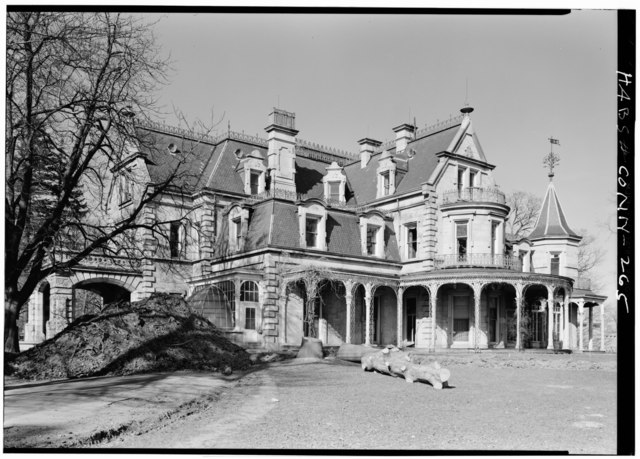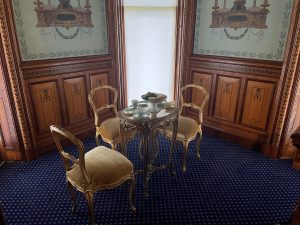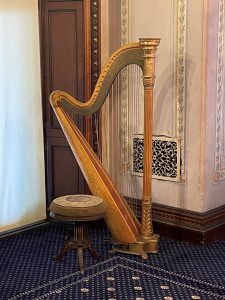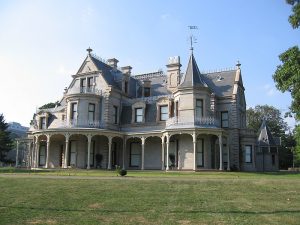By Emily Clark
An elaborate 19th-century home sits sheltered among tall elm trees near the intersection of Interstate 95 and Route 7 in Norwalk—a juxtaposition to the present-day busyness of Connecticut’s highways. This exquisite example of Victorian Era architecture provides a glimpse into the opulence of the Gilded Age when New York’s railroad tycoons built summer homes along the New England shoreline.
Constructed between 1864 and 1868, the Lockwood-Mathews Mansion is a significant model of Second Empire style. Overhanging eaves, ornate doors and windows, rectangular towers, and projecting bays give the home its unique outside design while carved moldings, crystal chandeliers, and parquet floors of imported rare wood create a magnificent interior. With more than 50 rooms across 44,000 square feet, this colossal residence on the National Register of Historic Places was home to two affluent New York businessmen before becoming a public park and museum.
LeGrand Lockwood Builds from His Fortune
Originally from Norwalk, LeGrand Lockwood led the lifestyle of a wealthy industrialist, similar to such families as the Rockefellers and the Vanderbilts. When he was still a child, his family moved to New York but he never forgot his boyhood home. A Wall Street success by the late 1850s, Lockwood established his own banking company and became the treasurer of the New York Stock Exchange. His additional role as director of the New York Central Railroad led him to become one of America’s first millionaires.
After his marriage to Ana Louisa Benedict and the birth of eight children (five of whom lived to adulthood) Lockwood decided—like many prosperous men of his time—to construct a summer home so his family could escape the heat of the city. LeGrand and Ana Louisa’s hometown of Norwalk was a natural choice. In 1863, Lockwood purchased 30 acres of land and hired Detlef Lienau, a European-trained architect, to lead the construction. The cost of building such a lavish estate was close to two million dollars thanks to indoor plumbing, hot and cold water, gas lighting, a skylight rotunda, and an elaborate heating system. For its time, this residence was one of unrivaled technology and convenience—though the Lockwoods called it their “country home” or “cottage.”
A patron of the arts, Lockwood included extensive artwork as well as elaborate details in every area of the house. The magnificent grand staircase in the rotunda featured carved posts with lion heads and exquisite patterns. The mansion’s rooms and hallways integrate black walnut doors, etched glass panels, columns of colored marble, and parquet floors. Lockwood included statues and paintings from his remarkable art collection—including Albert Bierstadt’s “The Domes of Yosemite.” Among other rooms, the conservatory and the library—with a collection of over three thousand books—highlighted additional aspects of the Gilded Age with embossed wallpaper and a textured glass dome.
Charles Mathews Assumes Ownership
Lockwood and his family moved into the home, which he called “Elm Park,” in the summer of 1868, though their time there was to be short-lived. After the “Black Friday” economic panic of September 1869 left Lockwood financially ruined, he mortgaged his Norwalk mansion and tried unsuccessfully to salvage his reputation on Wall Street. Misfortune continued to plague him, however, and he died of pneumonia at age 52 in February 1872. Lockwood’s widow Ana Louisa was unable to make payments on the mortgage, leading to foreclosure proceedings and the home’s eventual sale.
New York entrepreneur Charles Mathews purchased the Lockwood mansion as a summer retreat for his wife and children in 1876. Just three years later, however, he met a similar fate as the former owner, dying from a stroke. Unlike the Lockwoods, Mathews’ family continued to spend time at the home each summer until the death of his daughter in 1938.
The Gilded Age Lives On
Since the mid-19th century, the Lockwood-Mathews Mansion has been an illustration of American culture and history for wealthy industrialists of the Gilded Age. After its use as a private home ended, however, it served for a time as an office building and even a garage. Over the years, restoration projects allowed the building to regain much of its original splendor. Locals saved the house from possible demolition in the 1960s and it underwent extensive repairs—including those to the plaster ceilings and walls. In 1971, the Lockwood-Mathews mansion became a designated National Historic Landmark. Owned by the City of Norwalk since 1941, the Lockwood-Mathews Mansion Museum continues to undergo renovation, allowing the history of the Gilded Age to live on.
Emily Clark is a freelance writer and an English and Journalism teacher at Amity Regional High School in Woodbridge.












